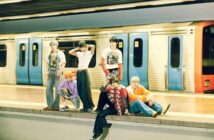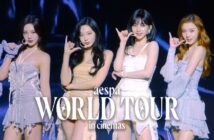Zion. T released “OO” at the beginning of February and the results were undeniably positive. I’d like to start by saying that before this album, I’d only listened to Zion.T’s music by random happenstance. I knew of him, and from what I could recollect, I liked his unique style, but his music wasn’t exactly my cup of tea. So, going into this review, I was rather excited to see what I would hear and think. I wasn’t expecting “OO” to be the production safe-haven I’ve been looking for for months. I listen to music constantly, and I’ve been doing reviews each month, and this album blew me away. It’s unlike anything I’ve heard in K-Pop, and honestly, it’s unlike anything I’ve heard – ever.
I’ll give you what I picked up from the album (AKA whatever I managed to scribble down in between incoherent ramblings about how good it is) but I implore you to listen to it, if you haven’t yet. I tend to remain unbiased throughout reviews, even with my favorite artists, but this album lead me into wobbly favoritism; with that being said, you may take what I say with a grain of salt, but I’d just like to say, even if it’s not your kind of music, it’s worth a listen from anyone who considers themselves a fan of music (literally any music) because, like me, it might just make your day and change your views.
As an album overall, there’s almost no set structure to each song. Zion.T has a flowing creativity that solidifies the feeling that each structurally impaired song is exactly as it should be. “OO” sounds like spoken word poetry met the Aphrodite of production and became best friends with the creator of foley, and I don’t quite know what we all did to deserve it.
1) Cinema
Starts with a film reel sound and an Elvis-esque, American 50s, tropical Jazz riff. The main melody throughout the entire song is a distinct acoustic guitar picking. His unique vocals have gentle backing vocals with a soft sandy shaker as the only percussion until the chorus. There’s a rattling sound at the end of each verse and chorus. The bridge gets a bit dirtier with a deep, rich stand up bass and heavy but infrequent rapping. After the bridge we get Zion.T’s token languid rapping and the instrumental is balanced well with the light backing vocals again. There’s a long, sweet fade of a shaker and the film reel sound.
2) The Song
Very cute vocals right away with really bright piano and great reverb. The verse has prominent snapping as the only accompaniment to his vocals and piano. At about 55 seconds a thick bass starts landing with the piano notes. His rapping is a bit faster than usual, mixed with cute vocal percussion (the “bap-bap-bap” dubbing) and he hits some beautiful (and delightfully nasally) high notes with clarity. Halfway through the piano drops out and he raps hard, giving you this teeth-gritting kind of satisfaction. There are quite a few interesting sounds happening in the back if you pay attention, such as the use of an organ along with electric guitar and clapping. The clapping replaces those prominent snaps at the end of the song and it ends abruptly, but not in an off-putting way.
3) Comedian
The beginning brings you right into the world of the song with about 20 seconds of laughter and applause, and I can’t tell if it’s creepy or not, but I’m kind of into it either way. Deep vocals with a soft, rich vibrato, sturdy piano, accompanied again, by prominent snaps. The song IS its well placed silences. The sound is very Funk, with the piano, and choice of drums, specifically a very sweet, soft kick and snappy snare. At about 1:20 there’s a gorgeous falling key drop with backing vocals. The song ends on a short, melancholy vibrato.
4) Sorry (feat. Beenzino)
Sorry starts off with a count-in and a much more classically R&B vibe and breathy vocals. To me, it’s a lot less captivating than the previous three tracks, but it still has you swaying with its funky bass lines. The backing vocals set a necessary tone for the song, and when Beenzino comes in it feels like it’s going to be harsh, but his Reggae rapping mixes surprisingly well with Zion.T’s clean higher notes. I noticed that the vocal descension and ascension throughout the song are placed really well. This track also ends a little abruptly, but once again, it doesn’t leave you feeling irritated in any way.
5) The Bad Guys
The track continues the album’s “tropical cinematic” feeling. There’s just one repeated vocal until almost a minute in, then his token speak-rapping until he hits us with a throaty sultry/soulful chorus; the mic-ing on his voice was so close and clear that you can hear his mouth move as he raps. The vocals have a spaced out mapping in the soundscape on top of the consistent instrumental (mainly acoustic guitar with an electronic loop). There’s very little change in the song’s instruments which is apparent in the instrumental bridge. It then goes into the same instrumental from the bridge but with a lovely backing vocal until the end of the song.
6) Complex (feat. G-Dragon)
Starts with the scraping of a chair on pavement in a wide Cityscape track, with the sound of a drink setting us off into light keys that somehow remain light while sounding appropriately heavy. More snaps! I think I might like the snaps as much as he does. There’s light vocal dubbing and lots of foley (distinct typewriter, cash register, city sounds, etc.) G-Dragon’s rap break sounds fairly similar to Zion.T’s vocals which lends a feeling of almost uncomfortable familiarity. The bridge gets really dark and almost dubstep/chillstep, with sporadic words and sounds bouncing off of the song’s walls – this was very noticeable to me because most of the song is very empty, letting you hear the dubbing more than the melody. The darkness ends as soon as it arrived and takes us back into the mellow Cityscape with a bright wind-chime leading us into the ending.
7) Wishes/Wind (2015)
Starts with a few writing sounds and goes into gentle acoustic guitar and light, clear, high vocals. The chorus draws you in and pulls at you. It sounds pained and joyful at the same time – a sort of distant nostalgia. He whistles in a noticeably off-tune way that’s distinctively on purpose, creating an even more distant but memory filled sound. His vocals remain high (in the front and back) and it’s hard not to get absorbed. He blows into the mic to create a fictitious wind at one point before going into a heavier guitar line and spread out but solid vocals in the bridge. His vocals come down into a more mid-range after the bridge and for the remainder of the song. The fade out of the song is the mellow instrumental met with his creative whistling.
8) Cinema (Inst.)
It’s just, really, really good, you guys. With my love of the song aside, it’s worth a listen because it lets you pick up on the things you might’ve missed the first time, and the clarity of each instrument on its own but also the clear blending gives it an easy-listening sound.
_____________________________________________________________
There’s only one official music video from the album. It’s for The Song.
But there was a short teaser video for the album, with Cinema, and I think it’s definitely worth watching.
You can buy the album on iTunes/Apple Music or stream it on Spotify.
What did you think of the album? Let’s discuss below!


![[Album Review] Zion.T – OO](https://unitedkpop.com/wp-content/uploads/2017/03/ARV_OO_Zion_T_TWIT.png)


